| Home |
| Acknowledgments |
| Conventions |
| Glossary |
| Maps |
| References |
| Links |
| Articles |
| Thumbnails |
| Species
list |
| Family |
| Next
species |
Additional Photos
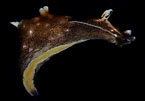
underside
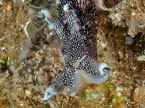
front

siphon

heavily spotted
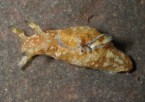
light
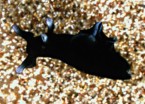
dark
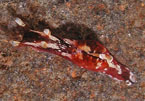
red

young
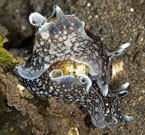
mating
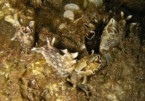
resting

shell

egg mass
_______________
GALLERY

Aplysia elongata (Pease 1860)
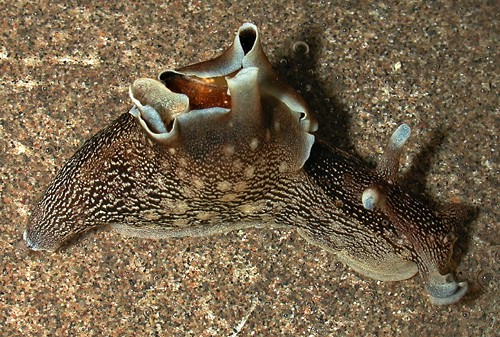
| Maximum size: about 70 mm (seldom over 40 mm). Identification: This sea hare varies from light cream flecked with white to velvet black. (Note 1) Rarely, it may have a reddish tinge. (Note 2) The edges of the parapodia, rhinophores and cephalic tentacles are powder-blue. The shell is usually visible between the parapodia (through the mantle pore) and there is a distinctive brown line crossing the protoconch. The siphon is asymmetrically folded. Natural history: Aplysia elongata is a common species found in rocky habitats and Halimeda kanaloana beds from < 1 to 23 m (< 3 to 75 ft). It occurs at protected to highly exposed sites. Small animals seem to be primarily nocturnal. However, larger animals appear to be primarily diurnal with all or most mating occurring by day. When populations are high, mating pairs are commonly seen on top of coral rubble or algae and they sometimes form mating chains of up to half a dozen animals. This appears to be particularly true when they are on or near a red algae tentatively identified as Laurencia nidifica. (Note 3) They eject a purple dye when disturbed and lay a tangled, greenish-brown egg mass. The eggs hatch in about seven days in the laboratory. Distribution: Big Island, Maui, Oahu, Kauai, Niihau, French Frigate Shoals, Midway and Kure. (Note 4) Taxonomic notes: It's referred to as the "small sea hare" in Hoover, 1998 & 2006. It was first reported from Hawaii in Pease, 1860 (as Syphonata elongata) and is listed as Tethys elongata in Edmondson, 1946, Ostergaard, 1950 and Ostergaard, 1955. It's listed as Aplysia parvula in Kay, 1979, Johnson, 1982, Kay & Schoenberg-Dole, 1991, Hoover, 1998, Hoover, 2006 (corrected in 2019 printing) and many other sources. Photo: CP: 40 mm; mottled: Hekili Point, Maui; March 21, 2005. Observations and comments: Note 1: On Oct. 25, 1997 a velvet-black and light animal were observed copulating in a dish. Also, dark and light mottled animals were seen paired in the field on April 10, 2008 (and on other occasions). This supports lumping the various color forms under one species. Note 2: There is some possibility that the reddish animals might represent a second Hawaiian species since the color form is more common in Japan. Note 3: Over the years, diurnal activity and mating have been observed many times in large animals living on patches of Laurencia nidifica(?) near the reef crest at Hekili Point. Although not confined to that substrate, the behavior seems more common there than in other locations. Perhaps, activity patterns are altered by the amount of defensive compounds retained from their food? Note 4: Golestani, et. al. (2019) recovered the Hawaiian population of what was formerly considered to be the widely distributed species, Aplysia parvula, as an endemic. |
| Thumbnails |
Species
list |
Family | Next species | Top |